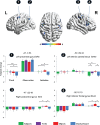Object words modulate the activity of the mirror neuron system during action imitation
- PMID: 29201543
- PMCID: PMC5698860
- DOI: 10.1002/brb3.840
Object words modulate the activity of the mirror neuron system during action imitation
Abstract
Background: Although research has demonstrated that the mirror neuron system (MNS) plays a crucial role in both action imitation and action-related semantic processing, whether action-related words can inversely modulate the MNS activity remains unclear.
Methods: Here, three types of task-irrelevant words (body parts, verbs, and manufactured objects) were presented to examine the modulation effect of these words on the MNS activity during action observation and imitation. Twenty-two participants were recruited for the fMRI scanning and remaining data from 19 subjects were reported here.
Results: Brain activity results showed that word types elicited different modulation effects over nodes of the MNS (i.e., the right inferior frontal gyrus, premotor cortex, inferior parietal lobule, and STS), especially during the imitation stage. Compared with other word conditions, action imitation following manufactured objects words induced stronger activation in these brain regions during the imitation stage. These results were consistent in both task-dependent and -independent ROI analysis.
Conclusion: Our findings thus provide evidence for the unique effect of object words on the MNS during imitation of action, which may also confirm the key role of goal inference in action imitation.
Keywords: action words; fMRI; imitation; mirror neuron; objects.
Figures




Similar articles
-
Fronto-parietal mirror neuron system modeling: Visuospatial transformations support imitation learning independently of imitator perspective.Hum Mov Sci. 2019 Jun;65:S0167-9457(17)30942-9. doi: 10.1016/j.humov.2018.05.013. Epub 2018 Sep 12. Hum Mov Sci. 2019. PMID: 30219273
-
Differential role of the Mentalizing and the Mirror Neuron system in the imitation of communicative gestures.Neuroimage. 2013 Nov 1;81:294-305. doi: 10.1016/j.neuroimage.2013.05.021. Epub 2013 May 17. Neuroimage. 2013. PMID: 23684882
-
Differential responses in the mirror neuron system during imitation of individual emotional facial expressions and association with autistic traits.Neuroimage. 2023 Aug 15;277:120263. doi: 10.1016/j.neuroimage.2023.120263. Epub 2023 Jul 1. Neuroimage. 2023. PMID: 37399932
-
Is the mirror neuron system involved in imitation? A short review and meta-analysis.Neurosci Biobehav Rev. 2009 Jul;33(7):975-80. doi: 10.1016/j.neubiorev.2009.03.010. Epub 2009 Apr 1. Neurosci Biobehav Rev. 2009. PMID: 19580913 Review.
-
The mirror neuron system and treatment of stroke.Dev Psychobiol. 2012 Apr;54(3):293-310. doi: 10.1002/dev.20504. Epub 2010 Nov 24. Dev Psychobiol. 2012. PMID: 22415917 Review.
Cited by
-
Mapping neural correlates of biological motion perception in autistic children using high-density diffuse optical tomography.Mol Autism. 2024 Aug 22;15(1):35. doi: 10.1186/s13229-024-00614-4. Mol Autism. 2024. PMID: 39175054 Free PMC article.
-
The effects of intranasal oxytocin on reward circuitry responses in children with autism spectrum disorder.J Neurodev Disord. 2018 Mar 27;10(1):12. doi: 10.1186/s11689-018-9228-y. J Neurodev Disord. 2018. PMID: 29587625 Free PMC article.
References
-
- Bekkering, H. , Wohlschlager, A. , & Gattis, M. (2000). Imitation of gestures in children is goal‐directed. Quarterly Journal of Experimental Psychology Section a‐Human Experimental Psychology, 53, 153–164. - PubMed
-
- Biagi, L. , Cioni, G. , Fogassi, L. , Guzzetta, A. , & Tosetti, M. (2010). Anterior intraparietal cortex codes complexity of observed hand movements. Brain Research Bulletin, 81, 434–440. - PubMed
-
- Bien, N. , Roebroeck, A. , Goebel, R. , & Sack, A. T. (2009). The brain's intention to imitate: The neurobiology of intentional versus automatic imitation. Cerebral Cortex, 19, 2338–2351. - PubMed
-
- Binkofski, F. , & Buccino, G. (2006). The role of ventral premotor cortex in action execution and action understanding. Journal of Physiology‐Paris, 99, 396–405. - PubMed
MeSH terms
LinkOut - more resources
Full Text Sources
Other Literature Sources

